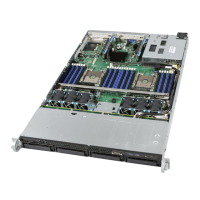Intel® Server Board S2600WF Product Family Technical Product Specification
31
2.5.1.5 BIOS Recovery
If a system is unable to boot successfully to an OS, hangs during POST, or even hangs and fails to start
executing POST, it may be necessary to perform a BIOS recovery procedure to replace a defective copy of
the primary BIOS
The BIOS provides three mechanisms to start the BIOS recovery process, which is called recovery mode:
• The recovery mode jumper causes the BIOS to boot in recovery mode.
• At power on, if the BIOS boot block detects a partial BIOS update was performed, the BIOS
automatically boots in recovery mode.
• The BMC asserts the recovery mode general purpose input/output (GPIO) in case of partial BIOS
update and FRB-2 timeout.
The BIOS recovery takes place without any external media or mass storage device as it uses a backup BIOS
image inside the BIOS flash in recovery mode.
Note: The recovery procedure is included here for general reference. However, if in conflict, the instructions
in the BIOS release notes are the definitive version.
When the BIOS recovery jumper is set, the BIOS begins by logging a recovery start event to the system event
log (SEL). It then loads and boots with a backup BIOS image residing in the BIOS flash device. This process
takes place before any video or console is available. The system boots to the embedded UEFI shell, and a
recovery complete event is logged to the SEL. From the UEFI shell, the BIOS can then be updated using a
standard BIOS update procedure defined in update instructions provided with the system update package
downloaded from the Intel website. Once the update has completed, switch the recovery jumper back to its
default position and power cycle the system.
If the BIOS detects a partial BIOS update or the BMC asserts recovery mode GPIO, the BIOS boots in recovery
mode. The difference is that the BIOS boots up to the error manager page in the BIOS setup utility. In the
BIOS Setup utility, a boot device, shell or Linux*, for example, could be selected to perform the BIOS update
procedure under shell or OS environment.
Note: Before attempting a recovery boot, it is highly advisable to reference the BIOS Release Notes to verify
the proper recovery procedure.
2.5.2 Field Replaceable Unit (FRU) and Sensor Data Record (SDR) Data
As part of the initial system integration process, the server board/system must have the proper FRU and SDR
data loaded. This ensures that the embedded platform management system is able to monitor the
appropriate sensor data and operate the system with best cooling and performance. Once the system
integrator has performed an initial FRU SDR package update, subsequent auto-configuration occurs without
the need to perform additional SDR updates or provide other user input to the system when any of the
following components are added or removed:
• Processor
• Memory
• OCP module
• Integrated SAS RAID module
• Power supply
• Fan
• Intel® Xeon Phi™ co-processor PCIe* card
• Hot swap backplane
• Front panel

